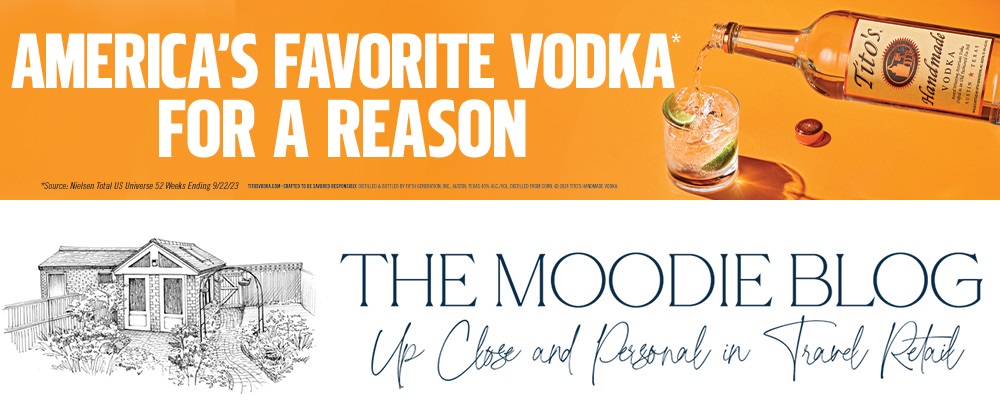Latest posts by Martin Moodie (see all)
- Time to paws Petsonality as Tito’s Handmade Vodka unleashes support for The Moodie Blog - December 22, 2024
- On the road to Mandalay where the Flying Kiwis play - December 15, 2024
- Finding a new way to shed Writers’ Tears in Galway - November 28, 2024

A long-tail boat makes its way across the early morning, mirror-like stillness of Phang Nga Bay. In the background the rich orange glow of sunrise appears to ascend from the waters alongside the majestic small limestone island of Koh Rang Nok that juts out from the Andaman Sea.
My Koh Yao Yai Interim Bureau is open, albeit sleepily so, for business. At around 30km long, Koh Yao Yai – literally ‘long and large island’ – is one of Thailand’s biggest islands and within easy reach of both Phuket and Krabi but thankfully it remains off the beaten track for most travellers.

Travel retail doesn’t get a look in here, unless you count the single 7 Eleven, situated not within any tourist enclave – in truth there aren’t any – but at a road junction.
I’m staying at the Anantara Koh Yai Resort & Villas, a superb property opened here just six months ago that feels built for purpose in restoring my energy and creativity after a long, hard slog without a meaningful break since before the pandemic.

There’s a beautiful serenity here, from the magnificence of the early morning sunrises to the calm of a pre-sunset walk along the beach, pretty much your only company the massed legions of horn-eyed ghost crabs scuttling along as if on stilts but burying themselves in the sand as you approach.



If the crabs – carefully protected here by man as well as themselves – don’t want company, neither do you. This is a place to simply let go, to feel the weight of mental pressure and physical tiredness dissolve.
In keeping with that ambience, the property owners are deeply respectful of nature, with careful wastewater and waste management ensuring no polluting of the pristine environment. Solar cells are in extensive use to generate electricity. Everything has been developed in sympathy with nature and local sensitivities.
The property is unquestionably luxurious but the beauty and simplicity of its surrounds and indeed the whole island makes this feel anything but an artificial retreat. Apart from the modest tourism industry, the largely (90%) Muslim population makes its living from rice farming, rubber plantations, coconut, palm oil and other crops.
You can take a 15-minute long-tail boat ride to Koh Yao Yai’s little sister island Koh Yao Noi, and there enjoy a sedate Tuk Tuk tour before dining on mantis shrimp or white snapper almost jumping out of the sea.



Alternatively stay on Koh Yao Yai and take the short motorbike or taxi journey to Laem Had, ranked 20th in The Top 100 Beaches on Earth 2023 by The World Beach Guide. At low tide, a kilometre-long stretch of dazzlingly white sand serves as a sandbar between Koh Yao Yai and Koh Yao Noi. It really is as picture-postcard perfect as it looks.

My first proper break since 2019 – though ‘the website that never sleeps’ is still maintaining its insomniac habits – has given me time to take stock of priorities amid what I see as a fast-evolving media and travel retail landscape.
There’s a lot of ‘noise’ out there in travel retail media land, perhaps too much. Since I launched what was then The Moodie Report in 2002, I have been a firm believer in two key editorial qualities – content and voice. Content is built on a combination of accuracy (most of all), relevance, insight, responsibility and speed.



Much of that stems from another critical quality often overlooked by journalists and other content disseminators – listening. You can only talk with anything approaching wisdom if you listen constantly and distil and learn from what you hear. Writing is not simply about typing.
Voice is less tangible – a combination of consistency, balance, positioning, opinion (to be used sparingly but well). In an age of social media overload, what often passes for voice is little short of bias or bile. I rarely monitor X (formerly Twitter) for that very reason or the reader comments below political articles.
To succeed in business, you have to differentiate yourself, particularly in crowded competitive sectors. That was my formula when I launched The Moodie Report in 2002 as the digital disrupter to an advertising-led, increasingly formulaic travel retail publishing world. Since then some of our competitors have copied our model (and often our content) with wearying, often shameless, predictability. But such is the reality of competition, don’t complain about it, simply stay ahead.
But neither I nor we will do that through more noise, more overload. This trip has helped me hone that perspective. Like most cliches, ‘less is more’ has attained that status for good reason. It applies as much to writing as it does to design, architecture or lifestyle. I shall increasingly adopt the principle to both my work and my life going forward. And like those horn-eyed ghost crabs, retrench to my burrow when I hear unwelcome noisemakers approaching. ✈



You must be logged in to post a comment.